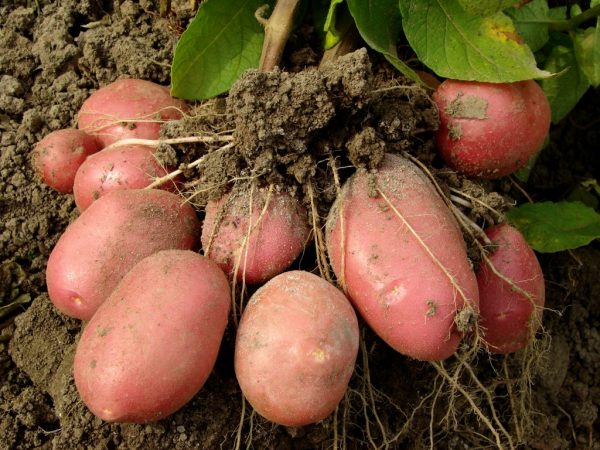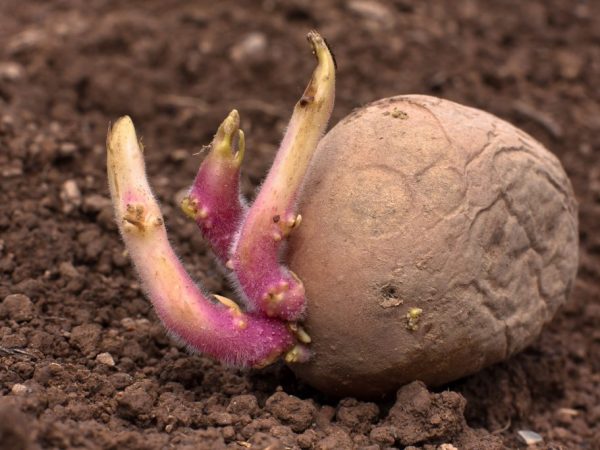Description of Potato Manifesto
The Manifest potato is an excellent vegetable crop that is widely used among farmers. First of all, this type is chosen for: resistance to diseases, weather conditions and, of course, for excellent taste.

Description of Potato Manifesto
Characteristic
The Manifest potato is a Belarusian variety that was bred by breeding several species. The hybrid fell in love among the people for its properties. This is a mid-season vegetable crop, the ripening period is from 90 to 110 days.
Description of the variety
Description of the Manifesto Potato variety speaks of the quality and high yield of the species. Harvesting from 1 hectare to 400 cents, which is very beneficial when growing vegetables on an industrial scale for production or sale. Customers in the market have long appreciated and loved the culture for its qualities. Delicious, boiling tubers will favorably emphasize the taste of your dishes.
The relatively high percentage of starch content allows the tubers to be used for processing. Also, due to its rounded shape, the vegetable crop is often used in factories for the preparation of chips.
Description of the bush
- The leaves are smooth, dark green, small and neat.
- The bush is not wide, directed to the top.
- The height of the bush reaches 60cm.
- Lilac flowers.
Features of the fetus
The fruits are round and slightly oblong in shape. The peel is light pink, easy to peel. The pulp is yellow, easy to boil, has a pleasant taste.
Characteristics of the fruits of this variety:
- fruits contain up to 15% starch;
- the weight of vegetables is from 100 to 200 grams, their number is up to 20 pieces from the garden;
- preservation is almost one hundred percent.
Advantages of the species
The characteristic of the variety allows the breeder to see a lot of advantages. Among the main advantages should be highlighted persistent immunity to many diseases, such as Late Blight and Cancer. The main thing to remember is that the presence of immunity is not a reason to neglect measures to prevent diseases. Another advantage is the versatility of the fruit, they can be used:
- when cooking: first, second courses, casseroles, chips;
- starch, which is isolated from tubers, is used in the food industry;
- also tubers are used in folk medicine;
- application in cosmetology: masks and lotions, for the skin of the face and hands.
Also among the advantages of the Manifesto potato variety is famous for its transportability and good preservation. That is why vegetables are excellently exported. It should be noted that the vegetable culture has a high content of vitamins and microelements. The high content of potassium and B vitamins will benefit anyone.
Self-germination of sprouts

Sprouting tubers is not difficult
For potatoes, the Manifesto, the description of the independent sprouting of a Belarusian variety will not be difficult, it is just worth doing some simple manipulations. Sprouted vegetable crops can be planted both in greenhouse conditions and in open ground.Germination of seedlings contributes to:
- acceleration of potato ripening by 14 days;
- prevention of diseases such as Brown Spot and Late Blight;
- germination promotes the accumulation of nutrients.
It is necessary to select the best tubers, arrange them in boxes in one layer, put them in a warm, illuminated place. Store vegetables in this form for about a month, at temperatures up to 15 degrees. As a result, you will get huge, greenish sprouts.
Planting and caring for the plant
Before planting tubers in the soil, aeration must be carried out, which will saturate the soil with oxygen. It is also important to take care of fertilization before planting. You can spice up the ground with chicken droppings or humus. The Manifesto potato variety is most often planted in the ground in early May, when the ground warms up to an optimal temperature of 10 degrees.
We dig holes at a distance of 40 cm from each other, put fertilizer from manure and a sprouted tuber on the bottom. We bury it with earth, making an elevation above the hole, such an action will retain heat and will contribute to the fastest growth. If you are afraid that your future harvest will suffer from frost, then a film should be stretched over the beds, thereby creating greenhouse conditions.
The distance between the rows should be about 70 cm so that you can move freely between the rows and provide space for the growth of the bush. During the growing period of the plant, it should be watered several times a week. Weeding to loosen the soil several times a month. You should also clean the stems of bad leaves and carefully monitor the general appearance of your plant.
Pest control
Chemical and biological control methods can be used to control harmful insects that are not averse to feeding on your vegetable crop. The most common pests are Colorado beetles, which eat the leaves and stems of the plant, which can cause disease and shrinkage of the bush, and with it your crop. In the fight against insects, insecticide treatment and manual cleaning of beetles and their offspring from the leaves will help you.
Huge insects, which are called Medvedki, are able to gnaw vegetables, causing them to rot or wither. A weak solution of vinegar, which is used to irrigate the soil, will help against the pest.
Blackfly larvae are also a threat to your harvest, they feed on potato tubers, making many moves in them. Small larvae can spoil about 30% of the crop. In order to avoid their appearance, you should initially adhere to the correct technology for storing fruits for planting. Planting early also helps to solve the larva problem.
Diseases
Among the most common diseases Late blight is in first place. The disease can spoil more than half of the collection. The infection is caused by fungi and multiplies very quickly. To avoid the disease and its consequences, only selected tubers should be used for planting. Use pre-germinated sprouts. Irrigation of the earth with a solution of lime and copper sulfate is also an effective method.
Brown spot is a disease that affects the leaves of a bush. It appears as brown spots on the leaves, which subsequently leads to their yellowing and drying. In preventive measures, you need to use mineral fertilizers.
Vegetable cancers affect about 30-40% of the crop. They form loose hardenings on the tubers, which leads to the loss of fruits. The method of combating the disease is the planting of germinated tubers, disease-resistant varieties.

